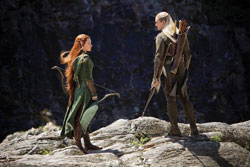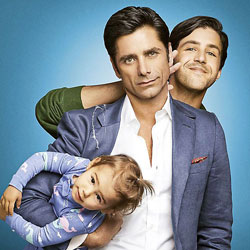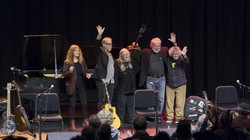Peter Jackson’s second installment of J.RR. Tolkien’s novel, “The Hobbit: The Desolation of Smaug,” follows a group of dwarves on a mission led by Thorin Oakenshield (Richard Armitage)to take back the lands that once belonged to the dwarves during their period of success, growth, and stability. Their homeland is demolished by the tyrannical dragon, Smaug (a CGI version of Benedict Cumberbatch) who uses his great size and strengths to destroy the land of Erebor, the kingdom of the Lonely Mountain, and acquire all its riches, leaving many slain.
Thorin, with the help of Gandalf (Sir Ian McKellen) the Grey Wizard, other dwarves, and Bilbo Baggins (Martin Freeman), treks into the Lonely Mountain in order to find the arkenstone—one of his most prized possessions lost among the riches Smaug claims in the Lonely Mountain
The film is filled with tremendous detail from the character’s personalities, which reflects Tolkien’s literary eloquence. The actors work well with that detail in order to make the story come alive and capture the audience’s attention. The visual effects make the hunt for the arkenstone all the more dangerous with the inflections in light in the Lonely Mountain and the drastic changes in color. The changes in color and light exemplify the unsettling fears of all people under Smaug, including Thorin and his pack. It also serves as a simple means of representing Smaug’s malevolent nature.
Smaug’s large size and thick, impenetrable armor contribute to his fierceness as well. Not only that, but the voice behind the dragon is effective in stirring fear in the eyes of both the audience members and onscreen characters. Benedict Cumberbatch lent his illustrious voice to the role of Smaug and does not fail in capturing said fierceness of the dragon. Cumberbatch not only voiced the dragon but also did motion capture for the dragon, meaning filmmakers used his face to model Smaug’s face. Cumberbatch’s role is definitely one of the most intriguing and engaging next to Martin Freeman’s part as Bilbo Baggins.
Bilbo Baggins is an example of courage in this film. He serves as a reminder of how the smallest of people could be just as, or more, powerful in mind and spirit than those bigger. His courage is shown in the depths of the Lonely Mountain while searching for the magnificent arkenstone and evading Smaug.
His loyalty to the dwarves and dauntless attitude drive him to complete his task, though it is not actually uncovered by the end of the movie whether or not he actually does pocket the stone. This was a smart move on Peter Jackson’s part because it certainly left everyone in the theater on the edge of their seats, fumbling in anticipation towards unfulfilled expectations. It makes the wait for the third film, titled “The Hobbit: There and Back Again,” all the better knowing that fate of the dwarves and all others under Smaug’s wickedness will still be in the hands of a hobbit who may or may not even have the key to redemption.
A calming excitement takes over as a shift in music occurs during the ending scene, into the credits as Ed Sheeran’s, “I See Fire”, filled the room. The rises and drops of the song coupled with Ed’s silvery voiced lyrics accurately illustrates the feelings of the characters on their dangerous journey fueled by both hope and fear of the fires inside them all as well as the literal fires that destroyed lives and homes. It is a fire expressed by the upswing in Ed’s voice mid credits that has a potential to completely take over surrounding lands and peoples. The song ends with light acoustics that again provide hopeful undertones that will be uncovered in the third film.
This film is highly recommended, along with the first, for those seeking a new thrill or cinematic adventure.
PHOTO TAKEN from digitaltrends.com




